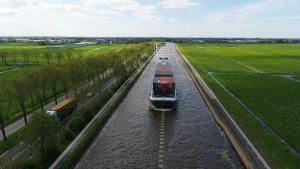The Green Deal for Shipping, Inland Navigation and Ports was signed on Tuesday 11 June 2019. The aim of the Green Deal is to make shipping, inland shipping and ports more sustainable. The main goal is to achieve emission-free and climate-neutral inland shipping by 2050. The government will make € 15 million available for this in the next two years. The results of the CLINSH project should make an important contribution to this.
Inland navigation: cleanest modality, now and in the future
The ambition of inland navigation is to remain the cleanest mode of transport, now and in the future. This concerns both CO2 reduction and reduction of emissions. One of the important agreements made is the reduction of CO2 by 35-50 % by 2035. This will be achieved in particular by blending sustainable biofuel. By 2050 there must be climate-neutral and emission-free inland navigation. This should be achieved by using cleaner engines, new technologies and adapting existing engines. The results of the practical tests from the CLINSH project will make an important contribution to these agreements.
Ports encourage and facilitate clean shipping
The Dutch inland ports are also committed to the objectives of the Green Deal. This will facilitate clean shipping. The ports are striving for a uniform system of differentiated rates and discounts on inland port charges. In addition, it has been agreed with the Ministry of Infrastructure and the Environment and with the Ministry of Finance that the energy tax on electricity used for shore-side electricity by shipping will be abolished.
Modal Shift
In addition, all parties are committed to increased efforts and resources for modal shift from road to inland shipping and rail. Shippers, the government, inland shipping and other sector organisations will work together on this.

